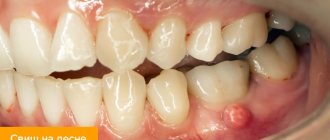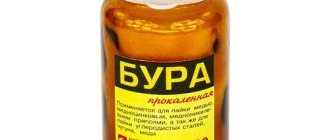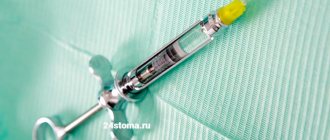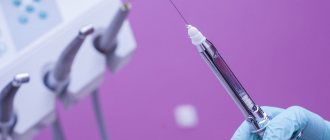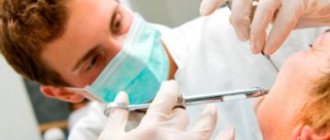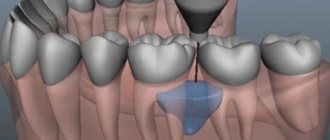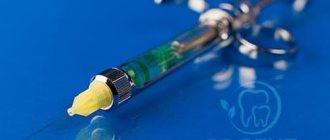04.11.2019
Anesthesia without adrenaline has been used in dentistry for quite a long time; it allows painless treatment even for those patients who have contraindications to common means of local anesthesia.
Typically, drugs that do not contain adrenaline are used in cases where it is necessary to treat teeth in patients with high blood pressure, heart disease, and pregnant or breastfeeding women.
General information about the drug, its composition and pharmacological properties
"Scandonest" is used in professional dental practice for the purpose of anesthetizing tissues before carrying out various medical procedures. The solution is administered by injection. It contains sodium hydroxide and chloride, saline solution, as well as the main active ingredient - mepivacaine. It is he who ensures the blocking of nerve patency, resulting in an analgesic effect. The drug is often used in patients who are hypersensitive to epinephrine.
After administration of the solution, the effect occurs after 3-4 minutes. The duration of action is approximately half an hour. After 1.5 hours, the drug is partially eliminated from the body. It should be noted that only 10% of the drug is excreted by the kidneys, and the rest of the impact is taken by the liver. Therefore, Skandanest is not recommended for liver diseases.
"Scandonest" is used in professional dental practice
Analogs
Analogues of the drug Scandonest contain one or more substances with identical effects. The following substitutes are used in medical practice:
- Isocaine;
- Mepivacaine;
- Mepivastezin;
- Mepidont;
- Mepicaton;
- Scandinips;
- Ultracaine DS;
- Articaine.
Isocaine
Isocaine, produced in Canada, is a local anesthetic medicine for blocking pain. The active ingredient is mepivacaine. The medicine is produced in injection ampoules intended for professional use. For local anesthesia, a 3% solution of the drug is administered, the dosage depends on the nature of the intervention.
Mepivacaine
Mepivacaine is a synonym for Scandonest, fully consistent with its composition and action. The drug is less toxic than lidocaine and also less effective. Mepivacaine is not recommended for use in patients with poor blood clotting. During soft tissue surgery, severe blood loss is possible, which can only be stopped by vasoconstrictor adrenaline. In some cases, patients are prescribed blood thinners several days before receiving Mepivacaine.
Mepivastezin
Mepivastezin is a drug for submucosal injection used in dentistry and for surgical interventions. The drug has local anesthetic and immunomodulatory effects. The active substance is mepivacaine. Mepivastezin is not recommended for use in patients with poor health or with severe kidney/liver pathologies. The drug is not recommended for use in early pregnancy due to its toxic effect on the fetus; breastfeeding can be continued one day after administration of the drug dose.
Mepidont
Mepidont is produced in Italy. This is a complex drug that contains mepivacaine and epinephrine. Epinephrine has a constricting effect on blood vessels and enhances the properties of mepivacaine. The drug is intended for professional use; prior consultation with a doctor is required before administration. Side effects are similar to other drugs based on mepivacaine, and allergic reactions are possible. Mepidont does not combine well with some medications, so on the eve of treatment the use of medications should be discontinued.
Scandinibsa
Scandinibsa, produced in Spain, based on mepivacaine, has local anesthetic properties and is administered by injection into soft tissue. Mepivacaine enhances the healing properties of other drugs that block the sensitivity of the central nervous system. Side effects occur due to sensitivity to the substances that make up the drug. In case of severe side effects syndrome, medical assistance should be provided. Eating is allowed only after the sensitivity of the nerve endings has been restored.
Ultracaine
Ultracaine is often used for treatment in the dental office. This drug does not cause significant side effects or contraindications. With the help of Ultracaine, a wide variety of dental procedures are performed, the patient does not feel pain. The drug is also used in pediatric dentistry, but after the age of four.
Important! Ultracaine is approved for use by pregnant women, but with the permission of a gynecologist.
The drug contains adrenaline, but in very small quantities. Ultracaine can be used to relieve pain in patients with high blood pressure and cardiovascular pathologies. In case of severe pain, the dosage of the drug may be increased.
Dentists give advantages to Ultracaine, which is several times greater than the effect of Lidocaine. The analgesic effect lasts a minimum of 20 minutes and can last up to 40 minutes. Ultracaine forte anesthetizes tissue within 1 hour 15 minutes.
Forms of release and estimated cost
The concentration of the active substance in the injection solution is 3%. One cartridge contains 1.8 ml, which corresponds to 54 mg of mepivacaine. The product is sold in blisters of 10 or 20 cartridges each. However, one package may contain different quantities. Approximate prices for Scandonest are shown in the table below.
| Number of cartridges | price, rub. |
| 20 | from 1500 |
| 30 | from 2200 |
| 50 | from 3800 |
| 80 | from 5900 |
| 120 | from 9 to 10 thousand |
The drug is available in cartridges
Pharmacokinetics
Injected into the oral cavity through local infiltration anesthesia, mepivacaine reaches its peak concentration in the blood approximately 30 minutes after the injection. The half-life is long and is approximately 90 minutes.
Mepivacaine is metabolized quite quickly and only 5-10% is excreted unchanged in the urine. Having an amide structure, mepivacaine is not metabolized by plasma esterases. The liver is the main site of its metabolism. Any liver pathology (cirrhosis, hepatitis) leads to a general accumulation of mepivacaine.
Indications and contraindications for use
This anesthetic is often used in the treatment and removal of teeth, for painless operations on the mucous membrane and jaw bone. It is used for conducting conduction, intraligamentary, intrapulpal and infiltration anesthesia in the upper and lower jaws.
Thus, among the indications for the use of Scandonest, one can highlight therapeutic treatment (filling carious cavities), treatment of fluorosis and enamel hypoplasia, nerve removal (depulpation), removal of teeth and inflamed roots, prosthetics and implantation, as well as medical procedures aimed at restoration conditions of the mucous membrane in diseases of the gums and periodontal tissues (gingivitis, periodontitis).
“When I turned 27, my last wisdom tooth came out. It grew crookedly and put pressure on the adjacent molar. It was very painful, it even began to fester. First, at my appointment, the dentist opened this abscess and told me to come back in 2 weeks. A planned removal has already been scheduled for the next appointment. I was still thinking about going under anesthesia, it was scary. But the doctor persuaded me to do simple anesthesia, scandonest. During the removal, I didn’t feel anything, although I was very tense and expected the worst. And by the way, yes, there was no such severe numbness of the tongue as had happened before. I don’t know, maybe the doctor just gave the injection correctly, or maybe it’s all thanks to this drug...”
Ruslan_88, from correspondence on the forum www.32top.ru
The drug can be used in dental treatment
. As for the restrictions on the use of the solution, experts include individual intolerance to the active substances, as well as severe systemic diseases, as absolute contraindications.
Among the relative contraindications, experts identify periods of pregnancy and lactation, problems with the liver and kidneys, disorders of the cardiovascular system, and inflammatory processes within the working area. In any case, the appropriateness of using an anesthetic remains at the discretion of the attending physician, who makes a decision based on an analysis of the individual characteristics of the body of each individual patient.
What is Adrenaline
Adrenalin is a hormone of the adrenal medulla.
It is usually obtained from the adrenal gland of cattle, and also synthetically from pyrocatechol. In addition to free adrenaline, various compounds can exist in the body.
The effect of adrenaline on the body causes reactions similar to the phenomena observed during stimulation of the sympathetic nervous system, accompanied by the release of sympathins - chemical mediators (conductors) of sympathetic nerve impulses.
Adrenaline is highly active in minute concentrations.
In medical practice, a solution of hydrochloric salt of adrenaline (Adrenalinum hydrochloricum solutum) is used in a concentration of 1: 1000.
The main pharmacological effect of adrenaline is the stimulation of the sympathetic nervous system (constriction of blood vessels in almost all areas of the body, with the exception of the vessels of the lungs, increased blood pressure, relaxation of the tone of the bronchial muscles, etc.). The use of adrenaline together with anesthetic substances in surgical practice is based on its local vasoconstrictor effect.
Adrenaline itself does not have any analgesic power, but only causes, as mentioned earlier, a narrowing of small vessels and capillaries.
It should be noted that the high concentration of adrenaline used by some practitioners for conduction and infiltration anesthesia in dental practice - 1 drop (1: 1000) per 1-2 ml of novocaine solution sometimes causes unpleasant phenomena even without the solution entering the vein: heartbeat, increased pulse rate, dizziness, fainting and sometimes even collapse. Slow injection of a fresh adrenaline solution heated to body temperature significantly reduces the toxic effect of the drug.
A weaker concentration of adrenaline during conduction and infiltration anesthesia in the dentofacial area (1 drop per 5-15 ml of solution) is less likely to cause unpleasant phenomena associated with the toxicity of the substance.
There are, however, people who are very sensitive to adrenaline and even when injecting the slightest dose of it, they react with general toxic phenomena (increased pulse, palpitations, pale face and even collapse).
Many times they tried either not to use adrenaline at all, or to replace it with less toxic substances, such as eserine, ephedrine, etc. But the elimination of adrenaline led to a decrease in the analgesic effect and to an increase in the toxicity of the anesthetic.
It should only be emphasized that for pain relief, adrenaline must be added to the anesthetic substance in the weakest concentrations. For conduction anesthesia, one drop per 5-10 ml of anesthetic solution is sufficient, and for infiltration anesthesia, one drop per 10-15 ml of solution is sufficient. When it is necessary to use a large amount of anesthetic solution, take one drop of adrenaline (1: 1000) for an even larger amount of anesthetic solution (one drop per 20-25 ml).
Instructions and recommended dosages
According to the instructions for use, the anesthetic is intended exclusively for injection. Before use, the rubber stopper and aluminum cap on the cartridge are pierced with a sterile needle, after which the solution is injected into the soft tissue within the working area. The exact dosage will depend on several factors:
- patient's age and weight,
- individual sensitivity,
- the type of anesthesia performed and the technique of its implementation,
- degree of innervation and vascularization of the area of anesthesia,
- the duration of the upcoming procedure.
The solution does not contain a vasoconstrictor to constrict blood vessels, but if it is necessary to prolong the analgesic effect, Scandonest can be administered together with adrenaline, including epinephrine, norepinephrine or methoxamine. Cholinesterases can also be administered simultaneously.
In pediatric dentistry
The drug is also suitable for use in pediatric dentistry. Since this anesthetic initially does not contain adrenaline, it can be administered to children under 5 years of age. At older ages, the use of vasoconstrictors is allowed. The dosage should be appropriate to the patient's age and actual body weight. Thus, the initial dose is usually 0.5 ml of a 3% solution, which corresponds to 0.025 ml/kg. If necessary, it can be increased to 2 ml, that is, up to 0.1 ml/kg.
The drug can be used in the treatment of children
In adult dentistry
For standard treatment procedures, 2-4 ml of solution (3%) is usually administered. The maximum permissible dose of the drug that can be administered within 2 hours for an adult patient with an approximate body weight of 75 kg is 6 ml. During the day, no more than 10 ml of solution is allowed. For elderly patients, the dosage should be reduced by half. The same applies to patients with coronary heart disease, renal and liver failure, and atherosclerosis.
Periods of pregnancy and breastfeeding
There is not yet sufficient and reliable data on the effects of the active substances of Scandonesta on the body of a pregnant woman or fetus. Therefore, as a precaution, doctors try to avoid using this anesthetic during pregnancy. The same applies to patients during lactation. If there are no other options, the drug can be used, but with extreme caution. If we are talking about lactation, the patient will be advised to stop feeding for 10 hours after the administration of anesthesia.
Use during pregnancy has not been sufficiently studied
Application in pediatric dentistry
Scandonest is used in pediatric dentistry, as it provides 100% pain relief and does not cause negative side effects. This is especially true for young patients under five years of age for whom adrenaline is contraindicated. After the age of five, children can be treated for pain with drugs containing adrenaline, for example, Ultracain DS. The dosage of the medicine corresponds to the age of the small patient.
The dentist’s work with the child should be carried out with the child’s complete trust in the doctor. After pain relief, the child gains confidence in the dentist and allows the necessary therapy to be carried out.
Possible side effects
Like any other medicine, in some cases Scandonest can provoke the development of adverse reactions. True, such troubles happen extremely rarely with this drug. Among the possible undesirable effects, experts identify the following conditions:
- from the central nervous system: impaired motor skills, lethargy, drowsiness, partial loss of tactile sensations, headache and dizziness, increased nervous excitement, anxiety, tremor and loss of consciousness,
- from the cardiovascular system: tachycardia, arrhythmia, bradycardia, low blood pressure, pain in the chest.
Side effects may include headache and dizziness.
There is a small chance of nausea and vomiting, urinary and fecal incontinence, and respiratory depression. An allergic reaction usually manifests itself as hives, itching and swelling at the injection site1. After administering the solution, the patient may feel numbness at the injection site, as well as on the tongue and lips.
It should also be taken into account that the drug inhibits motor functions, so immediately after its use it is not recommended to drive or start working with potentially dangerous equipment.
Side effects and cases of overdose
Undesirable effects after using an anesthetic are similar to reactions that occur with other groups of amide-type drugs. Most often they are associated with exceeding the recommended dose and can occur with overdose, rapid absorption or accidental intravascular injection.
The following symptoms are observed:
- the effect on the nervous system manifests itself in the form of headaches, drowsiness, weakness, dizziness and motor restlessness, convulsions, impaired consciousness, tremor, possible diplopia, nystagmus;
- The sense organs also change their normal functioning - visual and hearing impairments appear;
- on the part of the heart and blood vessels, a decrease in blood pressure, arrhythmia, collapse, bradycardia develops;
- disruption of the normal functioning of the gastrointestinal tract manifests itself in nausea, vomiting, and involuntary bowel movements;
- involuntary urination;
- respiratory failure to the point of complete depression;
- methemoglobinemia;
- allergies in the form of itching, skin rash, angioedema, anaphylactic shock, urticaria may appear on the skin and mucous membranes;
- fetal bradycardia;
- Swelling and an inflammatory reaction are possible at the injection site.
Overdose symptoms depend on the amount of substance administered. The severity of the condition may increase over time. All changes occur as part of neurological disorders with further toxic effects on the heart, blood vessels and respiratory system.
If an overdose is suspected, you should immediately stop using the drug. Access to oxygen must be ensured and, if necessary, an air duct is inserted and artificial ventilation begins. In addition, the patient is placed in a supine position.
If convulsions begin, barbiturates are administered intravenously. In case of cardiac arrest, emergency cardiopulmonary resuscitation is performed.
How does Scandonest interact with other medications?
To avoid an additive effect, the anesthetic should not be used in combination with a number of other medications. This category of drugs includes sedatives and antihistamines, as well as antiarrhythmic drugs that help reduce the frequency of contractions and myocardial conductivity.
The anesthetic should not be combined with certain drugs
Contraindications
- Known allergy to local anesthetic solutions belonging to the same chemical group.
Contraindications associated with the use of mepivacaine hydrochloride:
- severe myasthenia gravis;
- low levels of cholinesterases in plasma;
- serious liver dysfunction: cirrhosis, hereditary or acquired porphyria.
Attention athletes! Scandonest contains an active substance that may cause a positive reaction during anti-doping control.
Impact on the ability to drive vehicles or use machinery.
There were no effects of SCANDONEST 3% on vigilance, reaction time to visual stimulation or motor coordination in the studies.
Main incompatibilities: antiarrhythmic drugs (tocainide, etc.).
Anesthetics with similar effects
Analogs of Scandonest include anesthetics based on mepivacaine or other active ingredients. Among the anesthetic drugs in demand today, experts highlight the following injection solutions:
- Mepivastezin is based on the same active substance, so the indications for its use are identical to Scandonest. Allowed for use by children aged 4 years and older. Has additional immunomodulatory effects. Not recommended for patients with kidney and liver diseases, as well as pregnant women and during breastfeeding,
- "Ultracaine" is an anesthetic based on articaine, used for infiltration and conduction anesthesia. One of the most effective drugs from its group. Approved for use in children over 4 years of age,
- "Mepidont" is an anesthetic based on mepivacaine containing the vasoconstrictor epinephrine,
- "Scandinibsa" is a solution with mepivacaine as the main active ingredient. Allowed for children over 4 years of age, patients with diabetes, hypertension, heart failure and thyrotoxicosis. Suitable for patients with hypersensitivity to adrenaline.
Scandonest is a new generation of painkillers. The composition does not contain adrenaline, which has significantly expanded the range of its use. Like other modern solutions for local anesthesia, for example, based on articaine, this drug has proven itself to be an effective and safe anesthetic.
1Malamed S.F. Allergic and toxic reactions to local anesthetics, 2004.
Bottom line
Tooth extraction, removal of pulpitis and operations on soft tissues of the oral cavity should be carried out under local anesthesia. Scandonest in dentistry is a new generation anesthetic based on mepivacaine, which does not contain adrenaline. It can be administered to patients sensitive to the effects of adrenaline and who have contraindications to the use of lidocaine. This drug is also used in gynecology and in the treatment of other diseases.
Sources used:
- Solovyova A. A. (2015) Fundamentals of anesthesiology. Local and general anesthesia
- Manufacturer website Septodont (France)
- Anesthesiology and resuscitation, ed. Dolina O. A., M. GEOTAR-Media, 2006
- Bernardsky Yu. I. Fundamentals of maxillofacial surgery and surgical dentistry. - M.: Medical literature, 2000.




